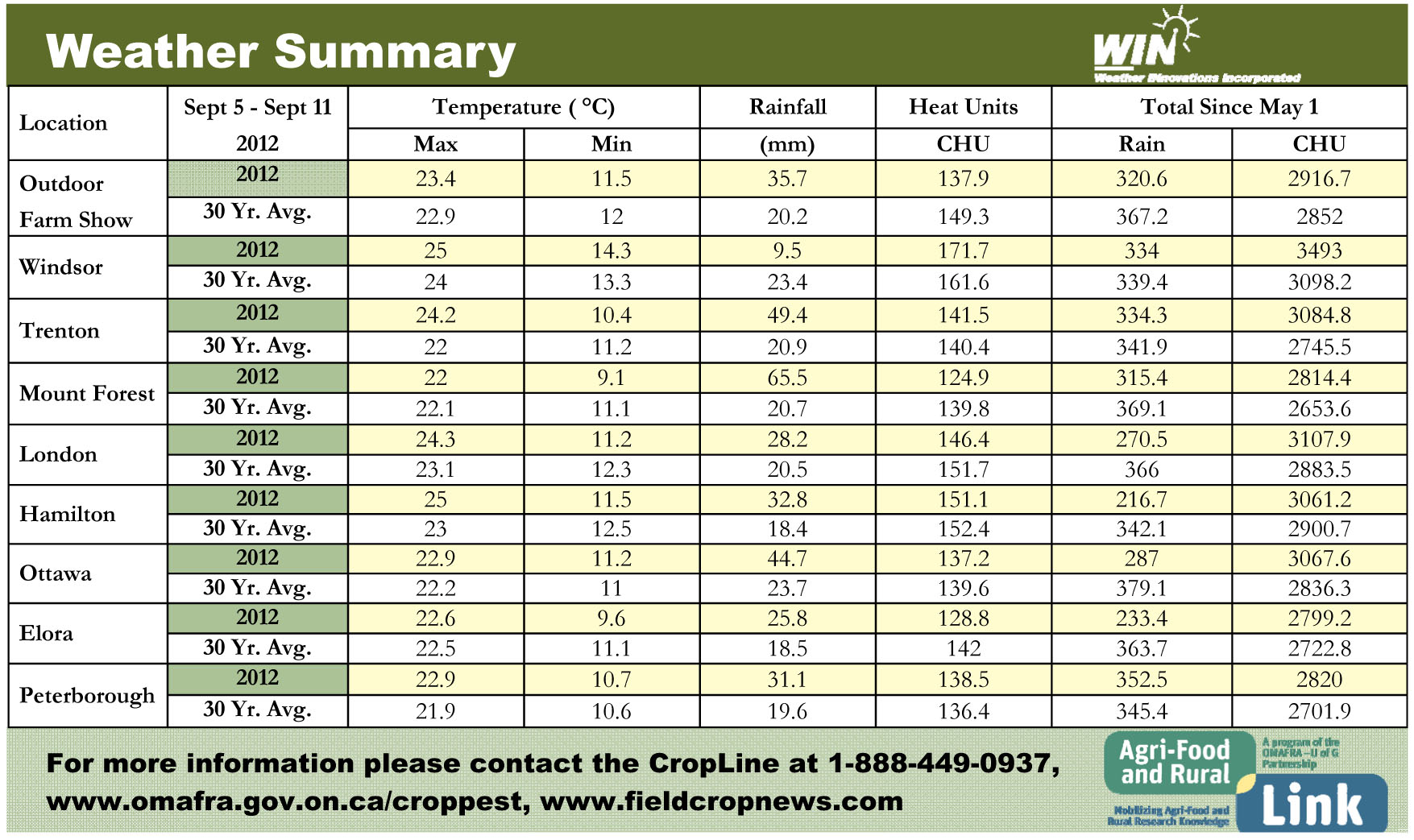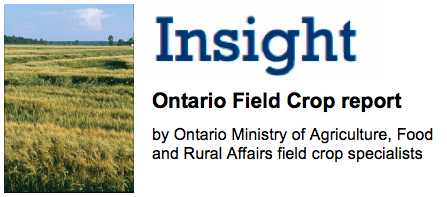Soybeans: Horst Bohner
Soybean harvest has now started, especially in shorter season areas and those regions that have remained very dry. Yields have ranged from the low 20’s to over 45 bu/ac, but are generally down compared to the long term average in fields harvested to date. Higher yields are expected in those areas that received timely rains and some regions will even see above average yields.
Green seed in the sample has been a problem, even though seed moisture was as low as 12% in those fields that have been harvested. Although a portion of the green seed will turn colour eventually, most of the mature green seed does not turn yellow if harvest is delayed. Generally speaking the best time to harvest the crop is the first time it dries down to acceptable moisture. Harvest losses and mechanical damage may be high when soybeans are harvested below 12% moisture. Losses can be minimized if a ground speed of 4-5 km/hr is maintained. The reel speed should be adjusted to match the crop conditions.
Corn: Greg Stewart
Silage harvest is winding down. Silo gas has been a major concern after the rain of Sept 4th. Be Careful! Take all appropriate precautions. See the forage section below. Yields have varied widely, from under 10 to approaching 30 t/ac. Silage is drying rapidly in stressed areas, with reports of moistures now below 50%. This silage will not ferment well in anything but a sealed silo.
Early grain harvest has begun in stressed areas, both for high moisture corn cob meal or dry grain. Producers will need to watch grain moisture to hit suitable high moisture targets as well. Yields are below average but better than expected. Cob drop is a major issue in some moisture stressed fields, with reports of up to 5% of cobs on the ground. Check fields and harvest immediately if cob drop is problematic.
Edible Beans: Brian Hall
Harvest has been a good news/bad news story. Stressed fields are disappointing, at 6-14 cwt, while good fields are surprising, 24-34 cwt. Seed size is small, but quality is good. Fields are maturing unevenly. Pre-harvest desiccants must be timed to the greenest areas of the field, or split fields and treat green areas later. Second growth in indeterminate beans (vine type) has resulted in two sets of pods, causing delays in staging for desiccation. Pre-harvest applications are working slowly with current cool nights and bean regrowth.
Forages & Pastures: Jack Kyle / Joel Bagg
Double cropping fall rye or winter triticale can provide an excellent, cheap source of additional forage to fill the gap when forage supplies are short. Farmers can plant fall rye following early-fall harvested crops, particularly corn silage. Forage rye harvested as haylage in mid-May can be followed by a later planted crop, such as soybeans, edible beans, or a warm-season annual forage such as sorghum. The timing of cutting is critical. Quality, palatability, and intake drop very quickly at the heading stage, faster than other cereals, so the optimum harvest window is very narrow. It is recommended to target harvesting forage rye at the flag-leaf or early-boot stage for high nutrient quality. At the early-boot stage, crude protein (CP) can approach up to 18%, depending on the amount of nitrogen applied, with Neutral Detergent Fibre (NDF) under 50%. At the head-emerged stage, CP drops to the 13 - 14% range, while NDF increases to over 60%. http://fieldcropnews.com/?p=5241
There is increased potential for silo gas (nitrogen dioxide) in recently harvested corn silage due to the dry growing season, so precautions should be taken. Farmers exposed to silo gas are at risk of permanent lung damage and even sudden death. Some of the reports of silo gas do not appear to have originated from severely stressed corn in the field. Silo gas is produced almost immediately after filling a silo. The greatest risk is the first 12 to 60 hours after filling the silo, and then risk declines for approximately 4 – 6 weeks when silage fermentation is complete. Silo gas has a bleach-like odour and is sometimes visible as a reddish-brown haze. Nitrogen dioxide is heavier than air, so it tends to be just above the silage surface. It may flow down silo chutes and into feed rooms. Tower silos are at greater risk because the silo gas is contained at the silage surface level, and operators often enter the silo after filling to level silage and set up the unloader. When inhaled, nitrogen dioxide mixes with body moisture to form nitric acid which causes severe burning of the lungs and respiratory system. Victims often collapse. Other people attempting a rescue can also be overcome. Farmers exposed to silo gas should get immediate medical attention. Do not enter a silo during the risk period without wearing an appropriate self-contained breathing apparatus. Before entering the silo, ventilate it by running the forage blower for 30 minutes and leave it running while inside. Also ventilate the silo room and chute. Post appropriate warning signs, and keep people and animals away. For more information refer to “Silo Gas Dangers” www.farmsafety.ca/public/factsheets/ silo_gas_dangers.pdf or contact the Workplace Safety and Prevention Services (formerly the Ontario Farm Safety Association) at 1-877-494-9777.




